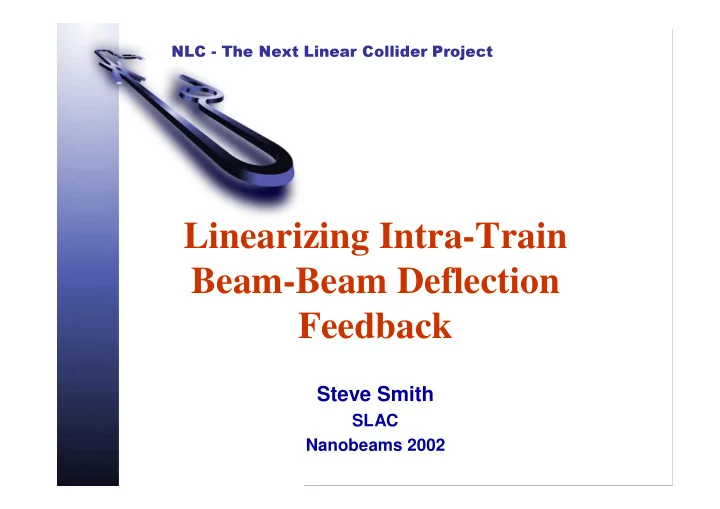

����� �������������������������������� Linearizing Intra-Train Beam-Beam Deflection Feedback Steve Smith SLAC Nanobeams 2002
Intra-pulse Feedback Next Linear Collider Next Linear Collider • Fix interaction point jitter within the crossing time of a single bunch train (266 ns) • BPM measures beam-beam deflection on outgoing beam – Fast (few ns rise time) – Precise ( micron resolution) – Close (~4 meters from IP?) • Kicker steers incoming beam – Close to IP (~4 meters) – Close to BPM (minimal cable delay) – Fast rise-time amplifier • Feedback algorithm is complicated by: – round-trip propagation delay to interaction point in the feedback loop. – transfer function non-linearity $XWKRU�1DPH Date Steve Smith Nanobeams 2002 Slide #
Limits to Beam-Beam Feedback Next Linear Collider Next Linear Collider • Must close loop fast – Propagation delays are painful • Beam-Beam deflection response is non-linear – slope flattens within 1 σ • Linear feedback converges too slowly beyond ~ 10 σ to recover most of lost luminosity. • May be able to fix misalignments of 100 nm with modest kicker amplifiers. • Amplifier power goes like square of misalignment. $XWKRU�1DPH Date Steve Smith Nanobeams 2002 Slide #
Non-linear Response Challenges Feedback Next Linear Collider Next Linear Collider • Beam-beam deflection non-linearity limits: – Limits useful (timely) range of convergence – Limits stability in collision $XWKRU�1DPH Date Steve Smith Nanobeams 2002 Slide #
Non-linear Response Challenges Feedback Next Linear Collider Next Linear Collider Optimize gain for small initial offset: Then convergence is poor from far out: Set gain for good convergence, then high gain at origin causes oscillation when near center: $XWKRU�1DPH Date Steve Smith Nanobeams 2002 Slide #
Linearize Feedback Next Linear Collider Next Linear Collider • Can we compensate non-linearity? – Fast? • Bandwidth • propagation delay – Accurately? • Yes! • Compensation Amplifier – Op-amp – Diodes – Bias adjust (knee or breakpoint) $XWKRU�1DPH Date Steve Smith Nanobeams 2002 Slide #
Schematic Next Linear Collider Next Linear Collider $XWKRU�1DPH Date Steve Smith Nanobeams 2002 Slide #
Model Next Linear Collider Next Linear Collider $XWKRU�1DPH Date Steve Smith Nanobeams 2002 Slide #
Measured Transfer Function Next Linear Collider Next Linear Collider $XWKRU�1DPH Date Steve Smith Nanobeams 2002 Slide #
Differential Gain vs. Amplitude Next Linear Collider Next Linear Collider $XWKRU�1DPH Date Steve Smith Nanobeams 2002 Slide #
Prototype Next Linear Collider Next Linear Collider $XWKRU�1DPH Date Steve Smith Nanobeams 2002 Slide #
Impulse Response Next Linear Collider Next Linear Collider $XWKRU�1DPH Date Steve Smith Nanobeams 2002 Slide #
Small-Signal Impulse Response Next Linear Collider Next Linear Collider $XWKRU�1DPH Date Steve Smith Nanobeams 2002 Slide #
Large Signal Impulse Response Next Linear Collider Next Linear Collider $XWKRU�1DPH Date Steve Smith Nanobeams 2002 Slide #
Propagation Delay Next Linear Collider Next Linear Collider $XWKRU�1DPH Date Steve Smith Nanobeams 2002 Slide #
Large Signal Waveform Next Linear Collider Next Linear Collider 1 V step Full BW Settles to DC response in several ns $XWKRU�1DPH Date Steve Smith Nanobeams 2002 Slide #
Small-Signal Waveform Next Linear Collider Next Linear Collider 10 mV step Full BW ~500 MHz $XWKRU�1DPH Date Steve Smith Nanobeams 2002 Slide #
Small-Signal Limited Bandwidth Next Linear Collider Next Linear Collider 10 mV step 150 MHz BW $XWKRU�1DPH Date Steve Smith Nanobeams 2002 Slide #
Simulink Model Next Linear Collider Next Linear Collider 10 mV step 150 MHz BW $XWKRU�1DPH Date Steve Smith Nanobeams 2002 Slide #
Non-Linear Feedback Simulation Next Linear Collider Next Linear Collider Compensated Uncompensated Full luminosity recovered in one round-trip time for 10 σ initial offset. $XWKRU�1DPH Date Steve Smith Nanobeams 2002 Slide #
Conclusions Next Linear Collider Next Linear Collider • Simple op-amp based non-linear amp is sufficient to improve: – Stability – Convergence speed � capture range – Programmable linearity compensation • Low propagation delay: ~ 1 ns • High bandwidth > 200 MHz • Sufficient to achieve: – Single round-trip convergence to < 1 σ from 10 σ initial offset. – Two-cycle convergence to < 0.1 σ from 10 σ initial offset. • Limited by dynamic range of present op-amp, • not by accuracy of compensation – Fix with another amplifier – Or diode bias • Breadboard prototype slightly peaky for small signals – Likely to be fixed with chip diodes in real layout – Ideally would make large signal response as peaky as small-signal response – (to compensate kicker fill time) $XWKRU�1DPH Date Steve Smith Nanobeams 2002 Slide #
Recommend
More recommend